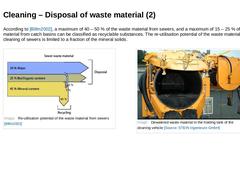
|
According to [Billm2002], a maximum of 40 – 50 % of the waste material from sewers, and a maximum of 15 – 25 % of the waste material from catch basins can be classified as recyclable substances. The re-utilisation potential of the waste material from the cleaning of sewers is limited to a fraction of the mineral solids. (Image: Disposal of waste material) (Image: Dewatered waste material in the holding tank of the cleaning vehicle) |
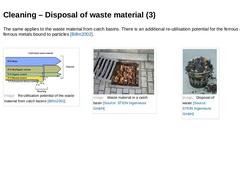
|
The same applies to the waste material from catch basins. There is an additional re-utilisation potential for the ferrous and non-ferrous metals bound to particles [Billm2002]. (Image: Re-utilisation potential of the waste material from catch basins) (Image: Waste in catch basin) (Image: Disposal of waste) |
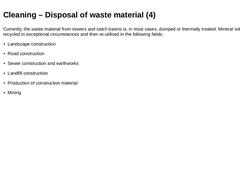
|
Currently, the waste material from sewers and catch basins is, in most cases, dumped or thermally treated. Mineral solids are only recycled in exceptional circumstances and then re-utilised in the following fields: |
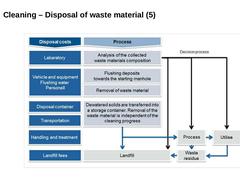
|
(Image: Cleaning – Disposal of waste material) |
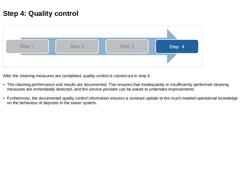
|
(Image: Arrow Step 04) After the cleaning measures are completed, quality control is carried out in step 4. -
The cleaning performance and results are documented. This ensures that inadequately or insufficiently performed cleaning measures are immediately detected, and the service provider can be asked to undertake improvements
-
Furthermore, the documented quality control information ensures a constant update to the much needed operational knowledge …
|
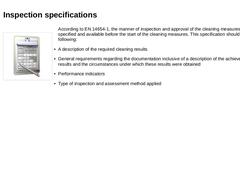
|
(Image: Picto Fakten) According to EN 14654-1, the manner of inspection and approval of the cleaning measures should be specified and available before the start of the cleaning measures. This specification should include the following: -
A description of the required cleaning results
-
General requirements regarding the documentation inclusive of a description of the achieved cleaning results and the circumstances under which these results were obtained
|
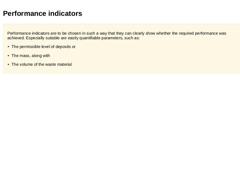
|
Important: Performance indicators are to be chosen in such a way that they can clearly show whether the required performance was achieved. Especially suitable are easily quantifiable parameters, such as: (Image: Permissible level of deposits) (Image: Mass of deposits) (Image: Volume of deposits) |
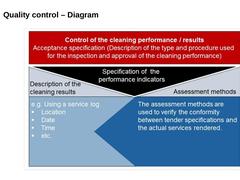
|
(Image: Quality control – Diagram) |
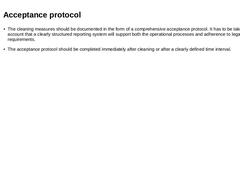
|
|
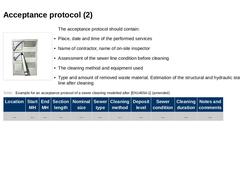
|
(Image: Picto Liste) The acceptance protocol should contain: -
Place, date and time of the performed services
-
Name of contractor, name of on-site inspector
-
Assessment of the sewer line condition before cleaning
-
The cleaning method and equipment used
-
Type and amount of removed waste material. Estimation of the structural and hydraulic state of the sewer line after cleaning
(Table: Example for an acceptance protocol of a sewer cleaning modelled after [… |
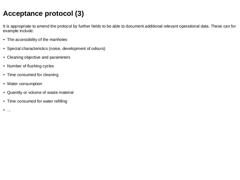
|
(Image: Picto Liste) It is appropriate to amend the protocol by further fields to be able to document additional relevant operational data. These can for example include: -
The accessibility of the manholes
-
Special characteristics (noise, development of odours)
-
Cleaning objective and parameters
-
Number of flushing cycles
-
Time consumed for cleaning
-
Water consumption
-
Quantity or volume of waste material
-
Time consumed for water refilling
-
…
|
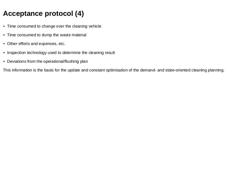
|
(Image: Picto Liste) -
Time consumed to change over the cleaning vehicle
-
Time consumed to dump the waste material
-
Other efforts and expenses, etc.
-
Inspection technology used to determine the cleaning result
-
Deviations from the operational/flushing plan
This information is the basis for the update and constant optimisation of the demand- and state-oriented cleaning planning. |
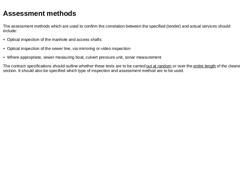
|
The assessment methods which are used to confirm the correlation between the specified (tender) and actual services should include: -
Optical inspection of the manhole and access shafts
-
Optical inspection of the sewer line, via mirroring, video inspection via cart or drone
-
Where appropriate, sewer measuring boat, culvert pressure unit, sonar measurement
The contract specifications should outline whether these tests are to be carried out at random… |
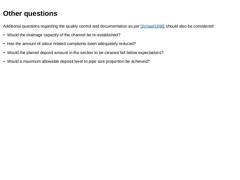
|
(Image: Frage) The following questions should already be considered with regard to quality control and documentation: -
Has the drainage capacity of the sewer been re-established?
-
Have complaints due to odour nuisance decreased to the specified extent?
-
Has the planned residual sedimentation height in the cleaned sections been undercut?
-
Was a maximum deposit height achieved as a percentage of the sewer profile height?
|
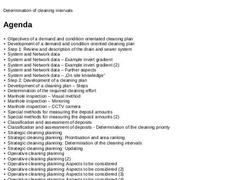
|
|
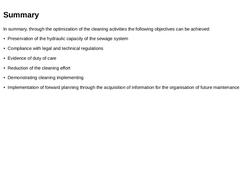
|
In summary, through the optimization of the cleaning activities the following objectives can be achieved: -
Preservation of the hydraulic capacity of the sewage system
-
Compliance with legal and technical regulations
-
Evidence of duty of care
-
Reduction of the cleaning effort
-
Demonstrating cleaning implementing
-
Implementation of forward planning through the acquisition of information for the organisation of future maintenance.
|
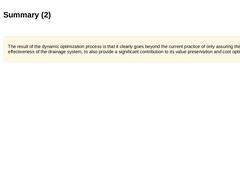
|
Important: As a result of the dynamic optimization process, it becomes clear that the task of cleaning sewer systems goes beyond the previous practice of ensuring the functionality of the drain and sewer system and makes a significant contribution to maintaining value and optimising operating costs. (Image: Cleaned, accessible sewer made of natural stone, and channel made of vitrified clay) |
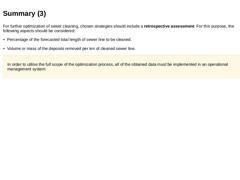
|
For further optimization of sewer cleaning, chosen strategies should include a retrospective assessment. For this purpose, the following aspects should be considered: In order to utilise the full scope of the optimization process, all of the obtained data must be implemented in an operational management system. |
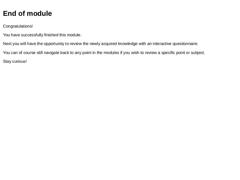
|
Congratulations! You have successfully finished this module. Next you will have the opportunity to review the newly acquired knowledge with an interactive questionnaire. You can of course still navigate back to any point in the modules if you wish to review a specific point or subject. Stay curious! |

|
|
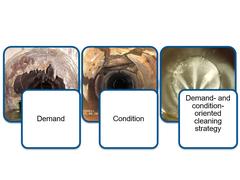
|
Operational processes in the cleaning of drains and sewers have a high ecological and economic optimization potential. Activating this potential is the overall objective of this module. After completing this module, you will have a sound knowledge of: - drawing up cleaning plans with special consideration of the structural condition of pipes and sewers and operating costs;
- possibilities for saving operating costs;
- differentiation of strategic approaches to cleaning.
|
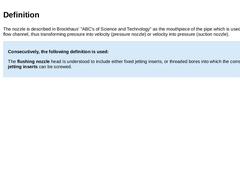
|
The nozzle is described in Brockhaus' "ABC's of Science and Technology" as the mouthpiece of the pipe which is used to narrow the flow channel, thus transforming pressure into velocity (pressure nozzle) or velocity into pressure (suction nozzle). Consecutively, the following definition is used: The flushing nozzle head is understood to include either fixed jetting inserts, or threaded bores into which the corresponding jetting inserts can be screwed. |
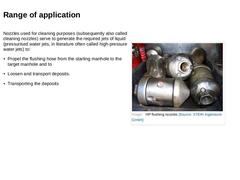
|
Nozzles used for cleaning purposes (subsequently also called cleaning nozzles) serve to generate the required jets of liquid (pressurised water jets, in literature often called high-pressure water jets) to: -
Propel the flushing hose from the starting manhole to the target manhole and to
-
Loosen and transport deposits.
-
Transporting the deposits
(Image: HP flushing nozzles) |
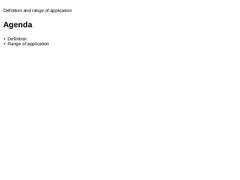
|
|
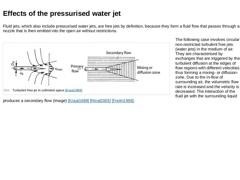
|
Fluid jets, which also include pressurised water jets, are free jets by definition, because they form a fluid flow that passes through a nozzle that is then emitted into the open air without restrictions. (Image: Turbulent free jet in unlimited space) The following case involves circular non-restricted turbulent free jets (water jets) in the medium of air. They are characterised by exchanges that are triggered by the turbulent diffusion at the edges … |